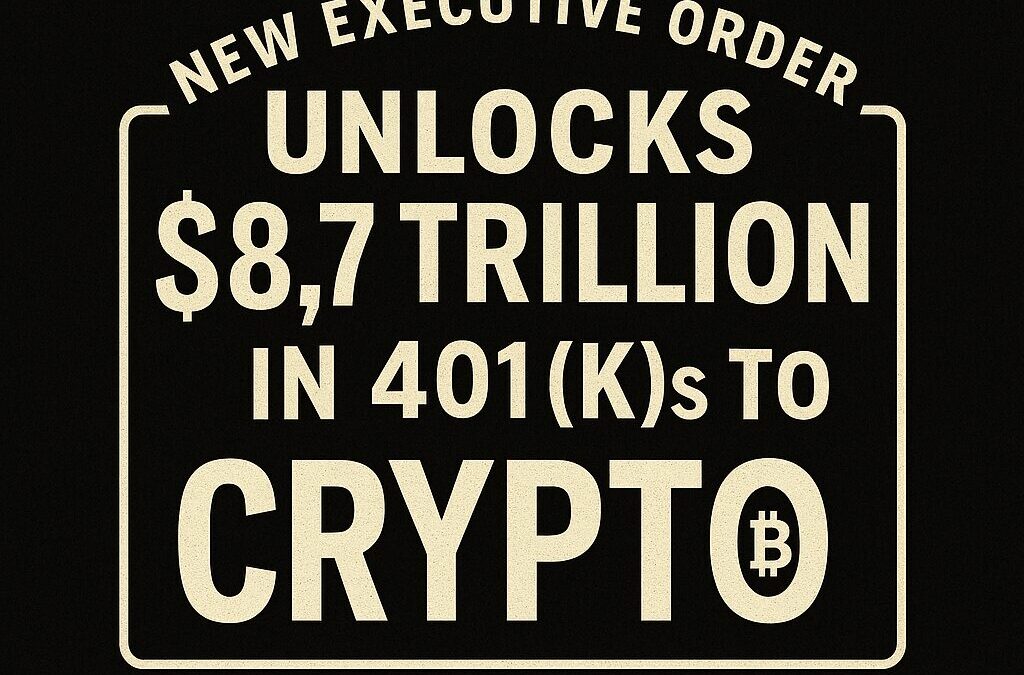$8.7 Trillion in 401(k)s for Crypto and Alternative Assets
In a landmark shift for the U.S. retirement landscape, a newly signed executive order has paved the way for 401(k) plans to offer exposure to digital assets—including cryptocurrencies—alongside private equity and real estate.
This directive tasks the Department of Labor, the U.S. Securities and Exchange Commission (SEC), and the Treasury Department with updating existing regulations to make room for these alternative investments. The aim? To modernize retirement portfolios and give American workers more choice—and potentially higher returns—in their long-term financial planning.
What This Means for 401(k) Investors
Historically, 401(k) plans have been limited to a narrow basket of traditional investments like stocks, bonds, and mutual funds. While this conservative approach has served as a safeguard, it has also limited access to high-growth sectors—particularly digital assets, which have gained traction globally among both institutional and retail investors.
With this new order, 401(k) plans could soon hold:
-
Bitcoin and Ethereum
-
Tokenized real estate assets
-
Private equity shares
-
Other compliant digital or blockchain-based products
According to data from the Investment Company Institute, Americans currently hold $8.7 trillion in 401(k) accounts. If even a small percentage of that capital is allocated into crypto or other alternative assets, it could have a seismic impact on market dynamics. For context, a mere 1% shift would mean $87 billion flowing into these markets—far more than the total inflows from U.S.-based Bitcoin ETFs this year.
A Game-Changer for Crypto
Financial experts are calling this a major step toward the mainstreaming of digital assets in the U.S. economy. According to Arrash Yasavolian, CEO of Glitch Financial, this order “creates simpler, more regulated onramps for individuals and institutions and adds a new element of legitimacy to asset classes like crypto.”
Beyond legitimacy, it addresses a longstanding barrier: accessibility. Most Americans interested in crypto have had to invest through personal brokerage accounts or dedicated crypto platforms—often with higher risks and fewer investor protections. This move allows retirement savers to diversify into digital assets through employer-backed, tax-advantaged plans, with fiduciary oversight and enhanced compliance standards.
Beyond Crypto: A New Era of Diversified Retirement
This isn’t just a win for crypto. The inclusion of private equity and real estate within 401(k)s marks a broad evolution in how we think about long-term investing. These asset classes have historically been reserved for institutions and ultra-high-net-worth individuals. Now, everyday savers could gain exposure to them within the same framework that has underpinned their retirement planning for decades.
By bridging traditional finance and emerging markets, this policy signals a maturing of the digital asset ecosystem—and a growing belief that the future of wealth building won’t be confined to Wall Street staples.
Conclusion: The Retirement Portfolio of the Future
As agencies work to revise regulations and establish safeguards, financial advisors, employers, and plan providers will play a critical role in guiding this transition. But make no mistake—the door is now open.
Crypto is no longer a fringe bet. It’s becoming part of the institutional core.
And for the 90+ million Americans with 401(k)s, the future just got a lot more diversified.

